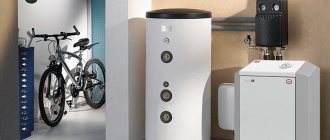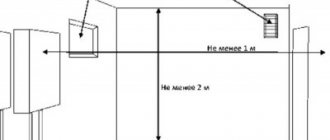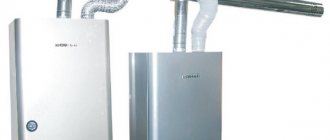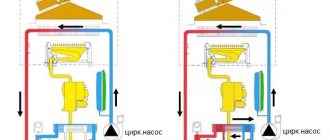Design and operating features of boilers
Modern gas boilers, depending on the number of circuits, can be single-circuit or double-circuit. They are externally and structurally similar, but are designed to solve different problems, and under different conditions.
As a result, it can be argued that both types of equipment are equally useful and effective, so there is no better one among them. So it all depends on the right choice. Next, we will look in detail at how the single-circuit type of gas boiler differs from its double-circuit counterpart.
Differences in the design of single- and double-circuit units
Products that belong to both types of equipment mostly consist of the same components.
The detailed design of a modern single-circuit wall-mounted boiler and the design diagram of its double-circuit “brother” are shown in the following figures:
Any single-circuit boiler is characterized by structural simplicity. Which makes them more reliable and affordable. But the listed advantages are offset by the need to buy a boiler
The presence of a complex heat exchanger and a three-way valve in a double-circuit unit makes it fundamentally different from any single-circuit analogue
The main components of the two types of boilers are similar - both the name and the purpose.
Thus, similar elements of single- and double-circuit equipment:
- cold water supply pipelines;
- gas-burner;
- membrane tank;
- chimney.
Even the structural element intended for heating water is called the same - a heat exchanger.
But, if you look at it, it turns out: the name is the only thing that makes the specified unit similar in different types of boilers - the heat exchanger of a single-circuit unit is a pipe that serves to effectively transfer the heat released during gas combustion to water.
An important difference between double-circuit boilers is that they are equipped with everything necessary for heating rooms and hot water supply. Therefore, there will be no additional costs for the purchase of equipment, and they also allow you to save space
But in the case of its double-circuit analogue, everything is not so simple, since its heat exchanger is structurally more complex. Moreover, such products are divided into separate subtypes and are bithermal and double .
In the first case, the structure is a pipe placed in a similar product of a larger diameter. This feature allows you to create 2 circuits , one of which is designed to transfer heat to the liquid used for heating, and the second for the hot water supply system.
The double heat exchanger consists of:
- pipes that provide heating of water for heating;
- plates that transfer heat to the liquid for water supply.
That is, the heat exchangers of double-circuit boilers differ in design complexity solely because of the need to solve 2 problems.
But still, the most significant difference between single-circuit and double-circuit products is the presence of a three-way valve . The purpose of which is to change the direction of hot water.
So in the standard position the valve is in a position in which the coolant is supplied only to the radiators. Everything changes when the hot water tap opens. Since the three-way valve, having received the corresponding signal, moves to another position. Namely, in the supply of hot water.
In this case, the supply of coolant to the radiators is stopped, and in full - the premises will not be heated throughout the entire time the hot water is used for domestic purposes.
That is, the design of a double-circuit boiler allows it to supply hot water only in one of two modes. But still, such a feature should not be considered a weak point of the equipment.
Comparative review of gas boilers
Both types of equipment presented are used to heat the coolant to heat rooms and buildings. And this is where the functionality of single-circuit boilers is limited.
A single-circuit gas boiler serves exclusively to heat the coolant entering the radiators of the heating system. But if you add an indirect heating boiler to it, then it, like its double-circuit analogue, will be able to provide hot water supply
Their double-circuit analogues are additionally used to provide hot water supply to solve any household problems. That is, they make it possible to take a shower, perform any other hygiene procedures, wash dishes, etc.
Next, we will conduct a comparative review of single- and double-circuit boilers according to a number of criteria.
| Comparison criteria | Single-circuit boiler | Double-circuit boiler |
| type of instalation | floor; wall | floor; wall |
| Additional investments | absent if there is no need for domestic hot water; if DHW is required, then you need to purchase a storage boiler | absent if there are no more than 2 sampling points and they are located next to the boiler |
| Economical | turns on when the water temperature in the boiler cools below the permissible level | the heating circuit turns on when the coolant cools below the permissible level; The DHW circuit turns on every time after water withdrawal starts |
| Compactness | when used in conjunction with a boiler, the space required actually doubles | more compact than single-circuit ones; wall-mounted models are suitable for use in limited spaces |
| Ease of use | when used in conjunction with a boiler, hot water will be the same temperature at all points of selection; The coolant is supplied evenly to the heating system | when the boiler power is insufficient and there are many water intake points, changes in the temperature of the water and coolant are possible, and sudden ones; When the taps are open, water is not supplied to the heating system |
As you can see, to organize hot water supply in the presence of a single-circuit boiler, you will have to buy additional equipment. For example, an indirect heating boiler. And these are additional expenses.
Moreover, after purchasing a boiler, it must be installed and connected correctly. We described in detail how to do this correctly and what to consider when operating such devices in this article.
Single-circuit heating boilers
A single-circuit boiler primarily works to heat rooms and create a comfortable temperature in them.
As the name suggests, one coolant circuit passes through the boiler. If desired, a heat exchanger can be connected to the heat source to heat the water. The operating principle of a single-circuit boiler is extremely simple. Fuel enters the firebox, which heats the coolant circulating through the pipelines inside the boiler. The coolant circulates through the heating circuit either due to the temperature difference or using a circulation pump. For high-quality heating of premises, water circulation in the circuit must be constant. single-circuit boiler with a connected boiler, hot water comes from the boiler
As for connecting an additional heating circuit, which is located outside the boiler, it will not be difficult to connect it. But is there any benefit to this? The thing is that connecting a boiler to heat water will make the operation of the boiler unstable. This is due to the fact that the amount of heat required to heat water is not constant throughout the day. Maximum water withdrawal occurs in the morning and evening hours. The boiler needs to be rebuilt and more fuel supplied to the burner. After cessation of consumption, the boiler remains to work only for the heating system. Such operation of a single-circuit boiler will not be economical and will lead to excessive fuel consumption.
Advantages of a single-circuit boiler:
- Such boilers are equipped with an automatic safety system. It is this that allows you to select the optimal operating mode of the equipment and fuel consumption.
- On the basis of single-circuit boilers, you can create a variety of heating systems with different wiring in rooms. The right choice allows you to increase the service life of the boiler, as well as improve its technical characteristics.
- New models of single-circuit boilers have built-in weather control sensors. This means that the outside air temperature regulates the fuel supply to the burner, and consequently reduces or increases the temperature in the supply pipe.
- The simplicity of the design makes single-circuit boiler models very reliable and easy to control and regulate.
What is the difference between a single-circuit and double-circuit boiler?
What is the difference between heating devices that do the same job? In their functionality. To put it very briefly, a simpler single-circuit device is a “specialist”, and a double-circuit design is double-acting equipment.
However, the basic, main function of both units remains heating the coolant for the heating system. Double-circuit boilers, unlike simpler single-circuit models, have an additional option - they “know how” to organize the preparation of cold liquid for hot water supply.
What is a single-circuit boiler
Single-circuit gas boilers are used to heat the coolant that fills the heating system. A single-circuit boiler does not prepare water for hot water supply. In rooms where the heated area sometimes exceeds three hundred square meters, floor-standing boilers are used. These heating devices are much more powerful than wall-mounted ones.
Wall-mounted single-circuit heating devices are most often used in high-rise apartments and can heat an area of up to three hundred square meters. These boilers are much more compact than floor-standing ones, and weigh just over 40 kilograms. The wall-mounted single-circuit boiler fits organically into the interior. Also, these wall-mounted devices are more functional than their floor-standing counterparts. The power of the most advanced models of wall-mounted single-circuit boilers is no more than 35 kilowatts.
A single-circuit gas boiler does not have any complex elements or mechanisms in its design. This boiler consists of:
- burners;
- heat exchanger;
- control unit;
- water pump;
- turbine electric motor (if the boiler has a closed combustion chamber);
- pressure gauge;
- sensors;
- shut-off valves.
Wall-mounted single-circuit boilers can be equipped with an expansion tank, which is hidden under the boiler casing. Also, the expansion tank can be part of a floor heating device, which has low power.
Design features, fundamental differences
A single-circuit boiler is used for heating premises by heating the coolant using 1 heat exchanger built into the boiler. Gas boilers, the design of which involves two heat exchangers, i.e. separately heating the coolant water for heating and hot water supply - called double-circuit.
Photo from ktl.by
Devices are classified:
- by location - floor and wall;
- in terms of energy efficiency: conventional, using a low calorific value and condensing, designed to consume a higher calorific value of fuel with the additional use of thermal energy released with condensate from water evaporation;
- according to the design of the gas burner - with an open and closed combustion chamber.
We also recommend reading: floor-standing or wall-mounted gas boiler, which is better and Top 10 best floor-standing gas boilers
When operating a gas boiler room, it is necessary to remember that gas is not only a benefit, but also a source of increased danger. Therefore, independent installation of equipment can lead to gas leaks and irreparable consequences.
To put it into operation, you must obtain a package of permits and consult with a specialist. It’s even better to entrust heating installation to professionals. You should not save on the health of your loved ones.
Rules for installing a coaxial chimney for a gas boiler
Acceptable placement of the outer part of the pipeRelated article:
Chimney for a gas boiler in a private house. In the publication we will look at the types of chimneys, selection criteria, materials, subtleties of self-installation and how to do it yourself.
The figure shows the restrictions that apply when installing a vertical coaxial chimney for a gas boiler. The application of these rules in practice will ensure good traction and prevent dangerous contamination of the immediate surrounding area. Horizontal structures are much more difficult to install correctly. You can clarify the current standards in SP 42-101-2003 and in SNiPs: 2.04.08-87; 42-01-2002; 02/31/2001; 2.04.05-91. Their compliance is mandatory. In case of violation, the corresponding gas equipment will not be officially registered for legal commissioning.
The purpose of the rules is to minimize the impact on humans and animals, and green spaces on the site. Fire safety measures are taken into account separately. Below are the main restrictions:
- a hole is drilled in the load-bearing wall 1/5 cm larger than the diameter of the outer pipe (the norm for brick/wooden buildings, respectively);
- the outlet of the coaxial chimney for a gas boiler is installed at a distance of 200 cm or more from ground level;
- in multi-storey residential buildings, the distance from the smoke exhaust system to window/door openings is 50 cm or more. It is doubled if such structural elements are located under the pipe. To neighboring buildings - at least 150 cm.
Expert opinion
Andrey Pavlenkov
HVAC design engineer (heating, ventilation and air conditioning) ASP North-West LLC
Ask a specialist
“In wooden houses, the free space between the pipe and the wall is filled with basalt fiber. This insulator maintains its integrity over a wide temperature range. However, it can be damaged by moisture. Protection from water should be provided to maintain the functionality of the insulation over a long service life.”
Unfortunately, there is still no comprehensive regulatory document that precisely establishes the rules for installing a wall-mounted or floor-standing gas boiler with a coaxial chimney. In current sanitary standards, for example, there is no mention of such devices at all. They indicate the need to place the outlets of smoke removal systems in such a way that harmful compounds and impurities are dispersed into the atmosphere. Such vague formulations are difficult to follow in practice. In accordance with the real situation, the Ministry of Construction of the Russian Federation recommends focusing on regional standards and official instructions from specialized manufacturers when designing.
The figure shows the distances from the coaxial chimney to the windows and other distances that are established by the German company DeDietrich
Recommendations for installation of the lower sections of vertical systems
Scheme for installing a gasket made of refractory material
Problems and correct solutions
Advantages and disadvantages of equipment
Both types of gas boilers are easy to operate, efficient and durable. They also have an attractive appearance.
The design of each type of gas boiler is designed to meet the needs of different categories of users, which clearly demonstrates their advantages and disadvantages. They also provide an opportunity to understand the differences between a single-circuit gas boiler and its double-circuit counterpart, helping the potential buyer make the right choice.
Pros and cons of single-circuit units
Such products are capable of providing stable heating of rooms of any size, number of floors, and distance from the heat exchanger.
And, in addition, single-circuit boilers:
- more reliable than their double-circuit counterparts, the design of which is more complex, which leads to a slightly larger number of breakdowns;
- easier to maintain , which is also caused by design features;
- cheaper.
An important advantage is that single-circuit units can become a base for connecting other equipment . This will expand their functionality and increase the comfort of living.
You should always remember that if you need to provide hot water supply in the premises, you will have to buy a storage boiler together with a single-circuit boiler. And this will lead to considerable additional costs. And a set of the listed equipment will take up a lot of space, which can be critical for small apartments
Connecting storage boilers will provide the premises with hot water supply. Moreover, the water will be supplied hot at any time, which is not always possible to achieve from dual-circuit analogues
This type of equipment, in the absence of the need for hot water supply, has no pronounced shortcomings. But otherwise, the lack of universality immediately affects. Which leads to the need to purchase an additional electric heating device.
As a result, its joint operation with a single-circuit boiler leads to:
- high costs for purchase, installation, maintenance;
- limited volume of water for domestic needs - boilers are most often purchased for joint use with single-circuit units, so the question may arise about the rational consumption of water, the volume of which depends on the capacity of the storage tank;
- greater load on the wiring.
The last drawback is relevant in cases where the house or apartment has old wiring or powerful electrical equipment is used in parallel. So, it may be necessary to modernize the electrical wiring and select a cable with a larger cross-section.
You should also be aware that a set of a single-circuit boiler and boiler takes up significantly more space than one double-circuit boiler. And with limited space this can be a significant disadvantage.
Advantages and disadvantages of double-circuit boilers
Units that belong to the specified type have some restrictions, but are still capable of providing hot water to two systems at once (heating, hot water supply). They also take up less space than their boiler counterparts. As a result, double-circuit boilers are more convenient to use.
Both types of gas boilers are easy to operate, efficient and durable. They also have an attractive appearance.
In addition, the competitive struggle of manufacturers has led to the fact that the difference in the cost of both types of units is gradually leveled out.
Therefore, today you can find a double-circuit boiler whose price is slightly higher than that of a single-circuit product. Which in some cases can also be considered an advantage.
If we talk about the disadvantages of double-circuit boilers, the most important is the inability to instantly provide hot water of the same temperature to all water consumption points in a house or apartment.
So, in their heat exchangers the amount of water that is needed right now is heated. That is, no stock is created. As a result, the water temperature may differ from what you expect or may change as you use it. This happens when the pressure or pressure changes, for example, after opening/closing the second tap.
When using a double-circuit boiler, the water temperature often differs at two different water intake points - hot water can be delivered to the desired point with a significant delay. Which is inconvenient and leads to additional costs
As for installation, installation of double-circuit boilers is a more complex procedure, especially at the design stage. Since you will have to follow numerous manufacturer’s recommendations
TOP 5 double-circuit gas boilers
Double-circuit boilers are considered the most preferred option among users.
This is true, although for families with a high need for hot water it is better to use single-circuit models with an external storage tank. Double-circuit units are convenient for small families or for use in public buildings. Popular models:
Vaillant turboTEC pro VUW 242/5-3 24 kW
German boiler from one of the most reliable manufacturers. It has a power of 24 kW, allowing you to heat rooms up to 240 sq.m. with simultaneous supply of hot water.
Unit parameters:
- installation type: wall-mounted;
- power consumption - 220 V 50 Hz;
- heat exchanger type - separate (primary copper and stainless secondary);
- Efficiency - 91%;
- gas consumption - 2.8 m3/hour;
- dimensions - 440x800x338 mm;
- weight - 40 kg.
Advantages:
- fully provides housing with heat and hot water;
- reliable stable operation;
- developed network of service centers.
Flaws:
- needs power supply stabilization;
- high price for boilers and spare parts.
Vaillant units are considered the most stable and reliable in operation. This is confirmed by ordinary users and service specialists.
Buderus Logamax U072-12K 12 kW
Gas boiler made in Germany. It belongs to the elite examples of European heating technology. The power is 12 kW, allowing you to heat 120 sq.m.
Characteristics:
- installation type: wall-mounted;
- power consumption - 220 V 50 Hz;
- Efficiency - 92%;
- heat exchanger type - separate (primary copper, secondary stainless);
- gas consumption - 2.1 m3/hour;
- dimensions - 400x700x299 mm;
- weight - 29 kg.
Advantages:
- stable and reliable operation;
- no noise;
- Ease of Management.
Flaws:
- high price;
- the need to use a power supply stabilizer and a water filter.
If you do not immediately install the filter units and stabilizer during installation and first start-up, you can quickly damage the unit and incur unnecessary costs for repairs and restoration of the boiler.
Bosch Gaz 6000 W WBN 6000- 12 C 12 kW
Gas double-circuit convection boiler with electronic control. Designed for rooms up to 120 sq.m., since its power is 12 kW.
Characteristics:
- installation type: wall-mounted;
- power consumption - 220 V 50 Hz;
- Efficiency - 93.2%;
- heat exchanger type - separate (primary copper, secondary stainless);
- gas consumption - 2.1 m3/hour;
- dimensions - 400x700x299 mm;
- weight - 28 kg.
Advantages:
- reliability, stability;
- no noise;
- low gas consumption.
Flaws:
- high cost of spare parts and repair work;
- demands on the quality of water and power supply.
Bosch products are known all over the world and need no introduction. The quality and reliability of heating equipment are considered benchmarks and serve as an example for other manufacturers.
BAXI LUNA-3 240 Fi 25 kW
Italian double-circuit convection boiler. With a power of 25 kW it is capable of heating an area of up to 250 sq.m.
Options:
- installation type: wall-mounted;
- power consumption - 220 V 50 Hz;
- Efficiency - 92.9%;
- heat exchanger type - separate (copper-stainless steel);
- gas consumption - 2.84 m3/hour;
- dimensions - 450x763x345 mm;
- weight - 38 kg.
Advantages:
- reliability;
- high performance;
- high-quality components and parts of the unit.
Flaws:
- high cost;
- The boiler dimensions are too large for a wall-mounted model.
Italian boilers are famous for their quality and reliability. However, to work in Russian conditions it is necessary to use additional equipment - a stabilizer and filter units.
Navien DELUXE 16K 16 kW
Korean boiler, characterized by relatively low cost and high quality. With a power of 16 kW, it is capable of heating 160 sq.m. area.
Boiler characteristics:
- installation type: wall-mounted;
- power consumption - 220 V 50 Hz;
- Efficiency - 91.2%;
- heat exchanger type - separate (both units are made of stainless steel);
- gas consumption - 1.72 m3/hour;
- dimensions - 440x695x265 mm;
- weight - 28 kg.
Advantages:
- reliability, high build quality;
- relatively low price;
- adapted to Russian conditions.
Flaws:
- high noise level (relative);
- Some parts are made of unreliable plastic.
South Korean boilers belong to the budget segment of heating technology. However, their quality is not inferior to their European counterparts, and the price is noticeably lower.
Comparison table of characteristics and prices
| Model | Installation method | power, kWt | DHW capacity (35°C), l/min (boiler volume, l) | Cost, rub |
| Double-circuit gas | ||||
| Lemax Premium-20N(B) | Floor | 20 | 4,3 | 30 000 |
| Baxi SLIM 2.230i 4E | Floor | 22,1 | 9,3 | 110 000 |
| Baxi ECO-4s 24F | Wall | 24 | 9,8 | 36 000 |
| Buderus Logamax U072-12K | Wall | 12 | 6 | 28 000 |
| Single-circuit gas + boiler | ||||
| Lemax Premium-16 + Kospel SWR – 100 | Floor | 16 | 100 | 23 000 + 14 000 |
| Viessmann Vitopend 100-W A1HB001 + Drazice OKC 200 NTR | Wall | 24 | 208 | 42 000 + 26 000 |
| Baxi SLIM EF 1.31 + Baxi UBT 200 | Floor | 30,5 | 200 | 60 000 + 26 000 |
| De Dietrich DTG X 30 N + Drazice OKC 200 NTR | Floor | 30 | 208 | 88 000 + 26 000 |
How to choose a boiler of appropriate power
If the choice in favor of a single- or double-circuit boiler has already been made, then it is necessary to select a boiler of appropriate performance. In order to ensure that the air temperature in the rooms is comfortable and the hot water temperature is about 50 degrees Celsius, you can make a simple calculation of the power of the installed boiler. To do this, the area of all heated rooms is summed up and divided by 10. This gives an approximate heating load. By increasing it by about 15-20%, we have the total power of the boiler, taking into account the hot water supply. However, as professionals advise, it is worth purchasing a boiler with a slightly higher productivity than that obtained by calculation. The thing is that over time, the performance of the equipment decreases, the heat transfer from the fuel to the coolant decreases, due to contamination of the heating surfaces. In addition, when selecting equipment, one should take into account the amount of heat loss from pipelines and possible voltage drops.
What is the difference between single-circuit gas boilers and double-circuit gas boilers?
When choosing which is better, a single-circuit or double-circuit boiler, you should thoroughly study the principle of operation, the similarities and differences of each type:
- Single circuit design – high performance. A flow-through coil or “water jacket” made of cast iron or steel is used as a heat exchanger.
- A device with two circuits - a heat exchanger surrounds a coil around the perimeter, connected to a hot water supply system or an indirect heating boiler built into the boiler body.
The difference between a heating boiler with two circuits and a boiler with one circuit lies in its purpose. Models without a built-in 2nd circuit are manufactured exclusively for heating, but with the possibility of additional conversion for hot water supply through an external boiler. Equipment with two circuits, capable of simultaneously working for the heating system and hot water supply.
Which boiler is more profitable - double-circuit or single-circuit?
Comparative gas consumption when operating single-circuit and double-circuit boilers shows that the first models are more economical. But this is valid only under optimal conditions, without taking into account the costs of installing and connecting an indirect heating boiler.
When considering cost-effectiveness, several factors are taken into account:
- Technical characteristics of units with two circuits. For heating equipment, the technical documentation indicates the throughput. This parameter shows how much hot water will be heated per minute. Typically, the coefficient is 10-15 liters for units using instantaneous heating, and 45-60 liters for models with a built-in buffer tank. If this volume is not enough, you will need to install an external storage tank.
- Costs for connecting storage capacity. A boiler costs from 40 to 80% of the cost of a gas heat generator (depending on the chosen model).
- Gas costs – a single-circuit design uses less gas, working exclusively to heat the heating system. After connecting the boiler, additional costs of 10-20% will be required to heat and maintain the temperature of the water in the tank.
Consequently, equipment with one circuit is more economical, but only if you plan to use the selected model of heating equipment strictly for its intended purpose. Connecting a boiler makes its own adjustments and makes the design with two circuits more economical.
Which gas boiler is better to choose - single-circuit or double-circuit
The difference between a single-circuit gas boiler connected to an indirect heating boiler and a 2-circuit one is that the first type of heat generator is not limited by the amount of heated water for domestic hot water. The storage capacity is selected individually, depending on the needs of the residents of the house.
The choice between single-circuit and double-circuit heating boilers is easy to make if you understand well whether and what volume of hot water is required at the output. If DHW is not provided or a large volume of heated water is required, it is better to install a unit with one circuit.
For simultaneous connection to hot water supply and heating system, with a cost of no more than 60 l/min, install a 2-circuit model with a heat exchanger and a coil for domestic hot water.
Which boiler is better to choose?
When choosing the best boiler, you should keep in mind that each type of equipment is designed for specific conditions. If followed, they will show maximum efficiency, allow you to achieve the expected result and mitigate shortcomings.
Therefore, it is so important to determine your requirements and take into account living conditions. So, if the equipment is selected for the apartment and there is no extra space for installation, then a double-circuit wall-mounted boiler would be the ideal option. And although it is inferior in power to floor-standing models, it is quite capable of meeting the needs of residents.
For a dacha or a private house where there is a separate room for a boiler room, an excellent solution would be to install a floor-standing single-circuit gas boiler in conjunction with a boiler of the required volume. This will ensure that the family needs hot water and heat.
When installing any model of a floor-standing single-circuit boiler with a boiler, an order of magnitude more space will be required than for double-circuit analogues. And the load on the equipment in this case will be higher, so it is important to correctly select the required boiler power
If you are selecting a heating unit for a country two-story house or cottage, then in this situation it is best to opt for a powerful double-circuit floor-standing boiler with a built-in large-volume heater.
Floor-standing gas boilers with one and two circuits differ in greater power from their wall-mounted “brothers”. They are also most often non-volatile . This is quite convenient, especially if there are power outages in the region.
We provided more recommendations and important criteria for choosing gas boilers in the next article.
Principle of operation
When choosing a boiler, take into account how the device functions. In a simple single-circuit model, if a boiler is not provided, the pump supplies coolant to the heating system until the desired temperature is reached. Afterwards the equipment goes into standby mode. That is, until the temperature drops to a given level, and then turns on again.
If the boiler is connected to the system, the fuel combustion process stops when the water indicator reaches the desired value. To reduce heat loss in such systems, it is recommended to install the container closer to the boiler.
A double-circuit unit in heating mode turns on the burner automatically, immediately after the temperature drops to the required level. During the combustion of gas, heat is transferred to the coolant, which then enters the heating circuit. That is, in this respect, the models are inferior to single-circuit ones. When the temperature rises to a preset level, the boiler turns off.
For hot water supply, the devices have a built-in boiler. The tank dimensions are limited compared to external tanks connected to single-circuit models. When choosing this option for a private house, they take into account how many people live in it, as well as the number of fence points. Buying a double-circuit boiler is not always profitable. While the equipment heats the water, the device does not heat the room.
Organization of hot water heating in boilers with one circuit
Despite numerous desires, it is impossible to turn a single-circuit boiler into a double-circuit one in the literal sense of the phrase. But you can retrofit a single-circuit boiler with an indirect heating boiler, sacrificing space and money, but providing hot water supply without all the disadvantages of double-circuit boiler models.
VIESSMANN gas floor-standing boiler in combination with a Vitocell-V 100 indirect heating boiler for 200 l.
The principle of operation is simple: inside the boiler with sanitary water there is a coil of the water heating circuit of the boiler; the coolant constantly circulates through the coil (as throughout the entire heating system of the house), maintaining a constant temperature. With this scheme, it is possible to ensure a relatively stable hot water supply not only when using a gas or electric, but even a solid fuel single-circuit boiler. With basic knowledge and skills, you can carry out the modification yourself.
Boiler manufacturers - which model is better?
It’s easy to get confused in the variety of brands offering their products. How to choose a boiler and not make a mistake with the choice. Currently, the heat and power products market mainly offers equipment from several countries. These are Germany, Italy, Korea and Russia. All boilers have some differences associated with the technical characteristics of their work and also significant differences in cost. German heating boilers.
Bosh boilers have proven themselves for a long time from the best side. Their design is constantly being improved. The boiler is equipped with automation and safety devices that regulate the fuel supply to the burner and are activated in the event of an emergency. To improve heat removal during boiler operation, all heat exchangers are made of copper, which are coated with a special composition to prevent corrosion. The estimated service life of such a boiler is 20 years.
Another German company producing high-class boilers is Viessmann
. They specialize in the production of both single- and double-circuit boilers. Their equipment is characterized by excellent assembly and technical characteristics. According to the stated characteristics, the efficiency of such boilers reaches 93%. In addition, the company's engineers have developed a unique chimney design that prevents condensation of flue gases in the pipe and, as a result, their freezing.
How to choose a boiler?
When choosing a gas boiler, three main parameters are analyzed: all technical characteristics, a reliable and trusted manufacturer, and cost. It is imperative to analyze the room in which the equipment will be installed.
The first thing you should pay attention to is the power and functionality of the equipment.
Criteria for choosing wisely
Important characteristics:
- Performance. The calculation is made after analyzing the area of the room and possible heat loss.
- Number of serviced circuits. If space heating and hot water supply are required, choose a double-circuit boiler with a pair of heat exchangers. If DHW is not needed, then a single-circuit boiler is sufficient. The new double-circuit heating devices provide a “Winter/Summer” mode.
- The material from which the heat exchanger is made. Steel or cast iron is used for the primary circuit, and copper and aluminum for the secondary circuit. The service life, thermal conductivity and cost depend on the material.
- Automation. It is provided in a double-circuit turbocharged boiler. There are two types: standard and weather-dependent. New models have built-in remote control units. The model can be additionally equipped with remote notification. Gas consumption depends on the number of automation functions.
The best models of gas boilers are produced by German companies. Italian and French products are in second place in popularity. Russia also began to supply competitive boilers that are low cost.
The most reliable boilers are Baxi, as well as Vaillant Turbo TEC, Viessmann, Vaillant Atmo TEC. In second and third place are models from Neva Lux and Arderia. Korean products from Navien, Hydrosta, Daewoo and Kiturami have low reliability and build quality.
Installation requirements
The highest demands are placed on the installation of atmospheric boilers. Installation and connection are carried out only by representatives of the gas company, with which an agreement is concluded for further maintenance and technical inspection of the equipment. All connecting nodes must be made perfectly, extremely tightly.
You can install a turbocharged boiler yourself. But you need to take into account that the slightest violation will lead to a decrease in performance, and the manufacturer will refuse warranty service
Turbocharged models are not so demanding, but manual connection is also not particularly recommended. Especially if, due to the fault of an inexperienced contractor, water gets into the gas pipeline
There is an important condition - perfect removal of smoke exhaust ducts to the street











